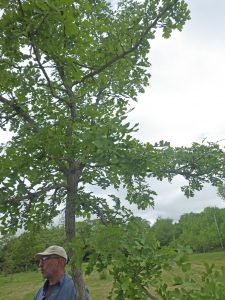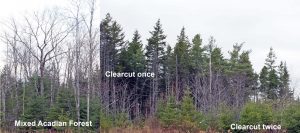In a paper published in Forest Ecology and Management in September and highlighted recently by a Canadian Press report (Oct 27, 2017), Anthony R Taylor of the Canadian Forest Service and six collaborators use a forest ecosystem simulation model to explore the impact of climate warming on the composition and growth of trees in the Acadian Forest Region under two climate change scenarios.
The eighteen most abundant tree species currently in our forests are included in the model. Only small changes in relative abundance of the different species are preedicted to occur over the short term (2011–2040).
Over the medium and long terms (2041–2100), the model predicts increasing relative abundance of warm adapted temperate species (American beech, red maple, red oak, white ash, and white pine) and reductions in the relative abundance of cold adapted boreal species (balsam fir, white, black and red spruces, eastern larch, jack pine, trembling aspen, and white birch) with the changes being most pronounced under the more rapid climate warming scenario.
Unexpectedly, the model predicts declines in relative abundance of sugar maple but the authors figured this was due to some deficiencies in the way the model simulates competition with sugar maple and American beech.
The model does not generate clear patterns of change for eastern white cedar, yellow birch, and eastern hemlock
The Acadian forest is a “transitional forest” with species drawn from the boreal forest to the north and hardwood forests to the south, thus in broad terms, these conclusions are not surprising and are in line with previous predictions (see links under Climate Change). The model provides a more precise time frame for the changes and a higher level of confidence in the conclusions than we had previously as it takes into account ecological variables such as the disturbance regimes and competition and involved simulation based on 988 provincial forest inventory plots.
A section in the discussion on Forest management implications provides the wake-up call:
Our study indicates that under a “business-as-usual” climate warming scenario [i.e. we don’t succeed in stopping climate warming], increased growth and establishment by warm adapted temperate tree species will alter the commercial tree species mix, changing the availability of some species-specific wood products. In particular, our results show a substantial reduction in the abundance of balsam fir and black and red spruce by the end of this century. The local forestry sector presently depends greatly on these species for the production of softwood lumber and pulp and paper. Our results also project a considerable gain in the abundance of red maple…Red maple is already an important source of fuel wood and hardwood lumber in the Acadian Forest Region…our projections indicate it will likely become an even more important economic species in the long term.
However, our results also show it is unlikely that the projected increase in growth and establishment by warm-adapted temperate tree species will keep pace with the loss of cold-adapted boreal species in the Acadian Forest, leading to a potential, overall decrease in average forest growth and wood supply during the latter part of this century. Our results support a growing body of evidence… that traditional commercial reliance on boreal conifers along North America’s boreal–temperate transition zone may become unsustainable in the near future and that adaptive forest management strategies, such as assisted migration or pre-commercial thinning treatments that favor temperate species, may have to be considered.

Bur Oak grown horticulturally at Grand Oaks on Grand Lake, Halifax Co., Nova Scotia. It occurs naturally in N.B. and elsewhere on the eastern seaboard, why not in N.S?
There are a dozen species of oak in Massachussetts, while there is only one species (red oak) native to NS. Should we be introducing species from New England to our forests (i.e., practicing “assisted migration”) to better adapt to climatic warming?
View Rapid 21st century climate change projected to shift composition and growth of Canada’s Acadian Forest Region by Anthony R.Taylor et al. 2017, in Forest Ecology and Management 405: 284-294.
Unfortunately the full paper is available only if you purchase it or have access to such articles through an institution such as a university. The Canadian Press article provides some further elaboration.
(Some scientific journals are “open access” and thus freely accessible, others such as Forest Ecology and Management charge the authors or their sponsors a fee to make an article freely available. Surely it would be a good use of tax payer dollars to make articles of this nature and which are based on research funded by the public available to all!)
—–
Assisted Migration refers to “the human-assisted movement of plants or animals to more climatically suitable habitats”. View The Natural Resources Canada webpage on this topic for more about it.

